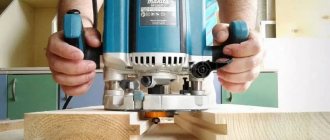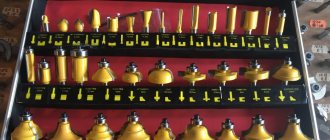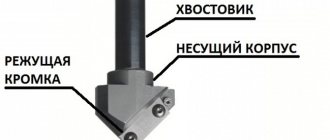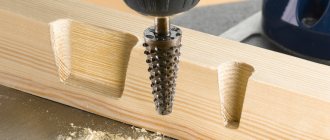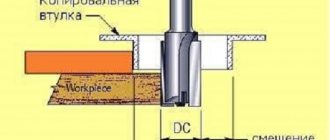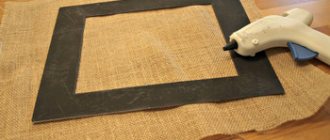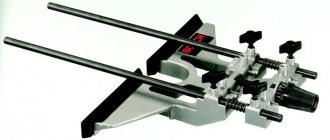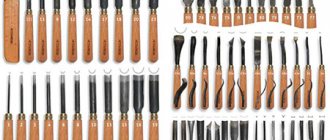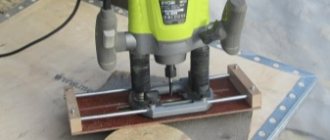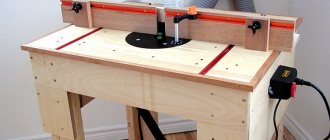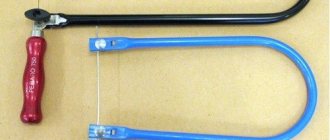A milling cutter is a cutting tool with which a manual milling machine or a stationary unit processes the surface of various materials (wood, plastic, metal). Since the equipment is designed for rotational movement, its basic shape will be disc-shaped or cylindrical. At the same time, the cutting edges of the tool can have a rather intricate shape. Hand milling cutters are divided into several types. The most common among them are for wood processing. At the same time, wood cutters also have their own classification. Let's look at what types of cutters are designed for processing wooden surfaces, and how to choose them correctly.
Slot cutters
If you need to select a groove of any depth and width, then a groove cutter is ideal for this purpose. Its design allows this operation to be performed both on the face (face) of the part and on its edge. A groove cutter is mainly used when joining parts into a tenon. Also, using attachments for a wood router that follow a ruler, you can cut even grooves of any width.
Shaped
They allow you to give the groove certain shapes, similar to curly braces. The tool not only selects grooves inside the workpiece, but also changes the shape of the edge ribs. When making a complex pattern on the surface of a workpiece, a straight cutter (groove) is first passed through it. In the future, this simplifies the alignment of the shaped equipment.
The following pictures show the main types of slotted router bits.
Structural
After processing the workpiece with this equipment, a groove is obtained that looks like a trapezoid (dovetail) or an inverted letter “T”.
This method of connecting parts is considered one of the most reliable, since the tenons are pushed into grooves of the same shape, and they cannot be separated by any other method.
V-shaped fillets
Although the word “fillet” refers to a semicircular notch or groove, V-cutters also fall into this category. The tool allows you to select not only vertical grooves, but also grooves at a certain angle. Also, a fillet cutter is often used for decorative carvings and changing the geometry of edges in furniture production.
Fillet
They have a rounded cutting part. If you look at the groove after it has passed through the section, it will resemble the letter “U”.
The cutter is used for decorative finishing of the edges and ends of wood products, creating complex patterns on the face of the workpiece or various fillet recesses (grooves) on the face of the product and on its edges.
Direct
This is the simplest tool, shaped like a cylinder. The groove obtained in the workpiece has a rectangular cross-section.
The equipment is most often used with plunge routers.
Straight groove (finger) cutters are used if you need to select a rectangular groove with a clean bottom, for example, for inserting door locks and hinges.
Types of cutter designs
Depending on the purpose and price, they can be produced in different design modifications.
Prefabricated
This cutter is based on a steel blank of the desired shape, and the cutting edges are welded to it. Due to the ease of manufacture, there are many similar models on the market.
With replaceable cutting edge
They have a long service life because the knives for them are made double-sided - if the blade becomes dull, it can be changed to the other side.
One-piece
The edges for cutting are machined into the base and when working with such tools, even in a hypothetical idea, the possibility of breaking the knife disappears, but after several sharpenings the cutter will still have to be replaced.
Blade Types
Milling cutters can be with inclined, vertical or even spiral blades. If we are talking about the first option, then pieces of wood will be cut off from the workpiece, and they will be cut off at an angle, which will minimize the likelihood of chipping and increase the overall quality characteristics of the milling.
Depending on the material of manufacture and characteristics of the blade, there can be two types:
- HM are high-speed, and they are used to process soft wood or metal such as aluminum.
- HSS are carbide, and they are needed for cutting hard materials, which is why such cutting edges have a much better temperature coefficient and other characteristics, and this is reflected in their cost.
In addition to the blades, depending on the exact location and the characteristics of the shape you want to obtain a recess in the workpiece, the appropriate types of cutters for a manual wood router are used.
Slot cutters
They are required in order to select a groove of the required width and recesses inside the part or from the edge to the center. Most often, groove cutters are used to create a tenon-groove joint, and if necessary, and also if the persistent design of the milling machine allows, the width of the groove can be adjusted without replacing the cutter with one that is larger in diameter.
Direct
This is the simplest tool that has the shape of a cylinder, and after its use a groove remains in the workpiece, which has a rectangular cross-section. It is perfect for use with plunge-cutting machines, although they can also be used with other models.
Fillet
Their cutting head has a rounded shape, and due to this, in cross-section the groove will resemble the letter “U”, but much will also depend on the depth of the cut, because the walls are rounded immediately from the workpiece surface and or initially emanate from it for a certain time at an angle of 90 degrees.
V -shaped fillets
By definition, a “fillet” is precisely a semicircular recess, but fillet cutters can also include those that have a V-shaped groove in the section. If the work involves making a groin with different angles of inclination of the walls, then you will need to have the appropriate set of tools with you.
Structural (“dovetail” and T-shaped)
Such grooves in cross-section form a shape that looks like an inverted letter “T”, with its base going to the surface in the form of a regular trapezoid, and the larger side facing the central part of the workpiece. This is one of the best types of connections, and the workpieces are inserted into each other, and it will be extremely difficult to separate them.
Shaped
Together with fillets, it is used to produce figured threads and edge processing. In cross-section, the manufactured grooves look very much like the usual brackets. You can rout the grooves in the center of the workpiece, or remove the edges from the edge. If you make a complex design, you will need to go along its contour with a straight groove cutter in advance - this helps to simplify the centering process, which will definitely be required in the future and will reduce the load on the milling machine when using shaped cutting.
Edge cutters
Most often, they are made with a bearing, which makes it possible to process the edges and ends of workpieces not only by adjusting the support tabletop, but also according to a template.
Direct
In order to obtain a plane end from a wood piece or a perpendicular face (we are talking about the upper part of the part that is being processed). If the cutter has a bearing, it will be possible to machine a round edge. The bearing itself can be configured flush to the cutting blade or even have a smaller/larger diameter, which will expand the possibilities of using the equipment.
Mouldings
In order to get an arched, straight or wavy shaped edge - it all depends on the part of the cutter used, because you can soften the edge of the workpiece, or round it (double cutters make it possible to do this in one go), create a rebated edge or even a half-rod protrusion They are often used to make ornaments of complex shapes, and when choosing double cutters, you should pay attention to the possibility of adjusting the distance between the cutting cutters.
Folded
A hand router edge cutter is used when you need to select a rectangular groin or even a quarter cut on a curved/flat workpiece. Using a double pass will produce a tenon of the desired size, and the depth of the cut will be adjusted by the position of the routing machine or by the thrust bearing.
Cone type
Depending on the angle of inclination of the milling edge, they are used to prepare the workpiece before joining, processing parts of furniture or obtaining a decorative chamfer, which will then be joined into polygonal or round shaped products.
Fillet
They are used to produce rounded grooves on the edge of a shaped or straight workpiece. To eliminate the possibility of misalignment, the cutters are made with two bearings. The result of the work is similar to what you could use groove fillet cutters, but most often the use of edge fillet cutters is much more convenient.
Curly type
Another name would be multidisciplinary. Due to the fact that they are quite large and simultaneously work with large surfaces of the workpiece, the use of such cutters is allowed on milling machines with a power of at least 1.6 kW. For work, the entire cutter profile is used at once or in different combinations, and this makes it possible to obtain an edge of a given or standard shape.
Half-rod
The direct purpose of the cutter will be to process the workpiece edges to obtain a semicircular protrusion. In addition, there are many additional uses - if you process a rectangular workpiece on both sides with such a cutter, it will certainly become a rod. Moreover, with its help, profiles with chamfers, as well as edges of complex shapes, as well as hinge-type connections are obtained (when processing a workpiece in conjunction with a molding or fillet cutter).
Combination cutters
Such cutters are used to join and consolidate wood blanks - to combine them at the edge (for a corner connection) or the end part (in order to obtain wide boards from several small ones). Combination cutters combine tenon and groove cutters, and they are designed to create both of these elements in one pass. The use of milling for this purpose helps to increase the bonding area of the boards and polishes the surfaces for maximum contact with each other.
Combined universal type
Such cutters for a manual wood router make it possible to obtain compatible planes with a groove and a tenon, which are placed at an angle to each other. The same cutter is used for two jointed workpieces - since it does not need to be changed, this helps to significantly reduce the processing time.
Tongue-and-mortise
A set of two separate cutters is used - to create a groin in one workpiece and a tenon in the second. Additional adjustments and measurements are not necessary, because the dimensions of the cutting edges were calculated when creating the tool.
To create a lining
They are used on a similar principle to the tongue-and-groove design, but they make it possible to obtain a shaped connection with a large area of contact between the workpieces, and this improves the characteristics of the lining created in a similar way.
Frame combined
These are typesetting cutters that give the master the opportunity to arrange the cutting blades on the axis in the order he needs. They are made of a base, cutting blades, thrust bearings, a retaining nut, and a lock washer. When changing the configuration, the base of the cutter is not removed from the collet of the milling machine so that the original setting is preserved
Edge cutters
In most cases, edge cutters have a thrust bearing. Thanks to it, it becomes possible to guide the tool along the template, processing the edges and edges of the workpiece.
Half-rod
The tool creates semicircular protrusions on the edges of workpieces.
If you use a half-rod cutter in combination with a molding or fillet cutter, you can make hinged joints. Half-rod tools are also used to produce round rods. In this case, the workpiece is processed on both sides.
Curly
These shaped cutters are also called multi-profile cutters. Depending on the tasks, the master can use part of the equipment profile or use it completely. In the second case, you will need to install the tool in a unit that has a power of at least 1600 W.
Fillet
Designed to give the workpiece ribs an internal radius or to make grooves with a circular cross-section.
Fillet cutters are equipped with one or two bearings, eliminating tool distortion.
Conical
Using cone cutters you can:
- chamfer the edge of the workpiece;
- decorate the edge of the tabletop;
- create an angular cut on the edges of the workpiece before gluing them (polygonal-shaped products can be obtained).
Also included in this category is an edge cutter with a blade angle of 45 degrees.
Folded
Used for cutting quarters and grooves of rectangular section. Thanks to the thrust bearing, the rebate cutter can be used on both straight and curved workpieces.
To adjust the groove depth, thrust bearings of different diameters are used.
The slotted disc cutter also falls into this category. With its help, a groove is cut in the workpiece for installing a T-shaped PVC edge.
Mouldings
Moulder cutters allow you to obtain an arched, straight, or shaped edge on a workpiece. Working with any part of the same equipment, you can:
- round the edge of the part;
- get a rebated edge;
- make a semi-rod protrusion;
- get edge with sponge;
- make decorative processing of the ribs, for example, making window frames.
You can also use molding cutters to create complex shaped ornaments on the edges and ends of a wooden part.
The equipment in this series can also be double, as shown in the following figure.
On a double cutter, the distance between the elements can be changed in accordance with the thickness of the workpiece. Thanks to two elements, the workpiece is processed in one pass, simultaneously on both sides.
Direct
A straight edge (overrunning or end) cutter is used for finishing the ends of a workpiece or creating an ideal 90 angle between the face of a part and its edge (end). The bearing can be installed at the top or bottom of the tool.
With the lower position of the bearing, the template is fixed under the workpiece, and with the upper position - above the workpiece.
In addition to the facing function, the equipment with the upper bearing can be used as a groove tool and cut a rectangular groove on the workpiece face, of course, using a template of a certain height. The diameter of the bearing is usually equal to the diameter of the tool, meaning it is flush with the cutting edge. But in some cases it is changed to a smaller or larger diameter in order to expand the capabilities of the equipment.
Milling cutter “corn”
The corn cutter is also an edging cutter. Its main purpose is to grind and align the edges of the workpiece according to the template. Thanks to the special arrangement of the knives (in a spiral), easy chip removal and smooth operation of the tool are ensured.
Areas of application
The scope of application of such cutters is usually limited to the processing of wooden workpieces. But in this area, a manual edge cutter will become an indispensable tool with which you can perform many different types of work with wood.
It is worth highlighting the main functions that an edge cutter performs when working on wood:
- Performing figured processing of edges is often used in the production of furniture or interior parts, such as baseboards.
- Milling of grooves and grooves of various shapes.
- Forming cutouts for installing door or window hinges.
- Making recesses necessary for mounting wooden decorative elements.
- Forming and trimming edges on laminate, solid wood or veneer overhangs.
The above operations can be easily performed using ordinary amateur tools. If you need to expand the functionality, you should turn to a professional tool. Unfortunately, it is most often impossible to use a set of professional cutting elements on an amateur tool, since each manufacturer produces equipment strictly focusing on the features of each tool.
Combination cutters
Splicing workpieces is considered most effective if combined equipment is used. These types of cutters consist of both tenon and groove elements: thanks to this design, the equipment produces both profiles in one pass . As a result, the area of the edge intended for gluing increases, which has a positive effect on the strength of the connection.
Framework
Frame cutters are compound tools. All cutting elements are installed on the base, and the master can place them in the desired order. Set cutters have the following components:
- base;
- cutting elements;
- bearing;
- washer;
- fixing nut.
When changing the location of the cutting elements, it is not necessary to remove the shank from the collet of the unit. It is enough just to unscrew the fasteners located at the bottom of the equipment, and all its elements are removed. Thanks to the dismountable design of the equipment, the tool overhang remains the same, and re-adjustment is not required.
Tongue-and-mortise
The kit contains 2 cutters, one for making a groove, and the second for a tenon.
Tongue-and-mortise cutters have a mirror-identical profile of the cutting elements, thanks to which the processed parts are joined as accurately as possible.
The only disadvantage of this equipment is that the grooves and tenons are made with different cutters, which have to be changed and again their offset relative to the base of the unit must be adjusted.
For the manufacture of lining
In their operating principle, cutters for making lining are similar to a tongue-and-groove tool, but the only difference is that when connecting the parts, a V-shaped groove is formed between them to imitate timber. To make the connection, a set of 2 elements is also required.
Universal
After passing the tool, 2 planes are obtained, completely compatible with each other, having a groove and a tenon. Both of the latter are located at an angle to each other.
A microtenon cutter is also used to splice parts.
The equipment can be used both for longitudinal splicing of workpieces (in the manufacture of panels) and for end splicing of parts.
For corner jointing of wood, equipment from a series of combined ones is also used, which allows you to prepare joints at an angle of 45 degrees.
It should be noted that the same combination cutter is used to process workpieces that need to be joined. The original design of the equipment makes it possible to achieve maximum quality of joining of parts, and also significantly saves time, since there is no need to change the tool.
Figurine cutters
The tool is used in the manufacture of panels, namely for decorative processing of the edges of parts. All equipment has a thrust bearing fixed at the bottom. A cutter with a bearing can process not only rectangular workpieces, but also shaped ones. You should know that paneling tools have a diameter of 50 to 70 m, so in order to use them effectively, you must have a device with a power of at least 1500 W. For a household router, processing panels with this type of equipment will be an impossible task.
To make doors using a manual milling cutter (meaning kitchen facades), you will need to purchase a special set consisting of three elements.
The set contains the following facade cutters: one panel cutter and two accessories for furniture trim (profile-counter-profile).
Horizontal
Used for pre-treatment of panels. To form a tenon for insertion into the frame groove, additional processing of the edge will be required.
Vertical
Most often, vertical figurine cutters are used to make baseboards.
Horizontal double-sided
This type of equipment significantly simplifies the production process, since in one pass of the tool a connecting tenon and part of a panel of a certain configuration appears on the edge.
In addition to the above types of equipment, many craftsmen also use homemade cutters. They are usually standard plumbing drills, sharpened in a special way. You can learn how this is done at home from the video.
Designs of cutters and their influence on the technology of milling operations
Wood cutters for a manual router can have stacked and monolithic designs. In the first case, the design of the tool is a certain set of plates made of high-speed steel, which are attached to the cutter shank by soldering with copper alloys (sometimes, in cheaper sets, tool steel is used instead of a carbide alloy, and alloy structural steel is used as the shank material).
In the second case, the cutter is a monolithic tool, which is made of tool steel. A special type of cutter for a hand router is formed by mounted cutters, which consist of a removable plate, which is then mounted on an adapter shank. Such cutters are the most technologically advanced to use, since when the cutting blade becomes dull on one side, the removable plate can be turned over to the opposite side and continue to use the tool.
When choosing a set of tools in question, pay attention to the following:
- Soldering of typesetting cutters must be done in such a way that the tool does not lose its longitudinal stability during long-term processing, especially if the workpiece is made of hornbeam, pear, oak and other hardwoods;
- When soldering tools, grades PSr40 or PSr37.5, with a high content of silver and copper, should be used as solders. Solders of other brands usually include nickel, which impairs the strength of the connection between the plates and the shank;
- The easiest way to check the thermal strength of a set cutter is by the thermal deformation of the tool during heating of each tooth to a temperature of 200...2500C: the tool after such heat treatment should not allow its longitudinal axis to run out by more than 0.05 mm;
- The stacking cutter should not be made by welding the shank to the working cutting part. Firstly, at the site of the weld, the strength of the metal is always reduced by 15...20%, and, secondly, with sharp impacts (for example, when cutting a cutter into hard wood), chips may appear on the surface of the weld. The use of such a cutter is unacceptable.
It is especially worth highlighting the problem of the hardness of cutters for a hand router. Manufacturers of sets of such tools may be from China. The price of such a tool is noticeably lower, but the quality of the metal from which the equipment is made also decreases. Most often this concerns monolithic cutters. It is impossible to evaluate the steel grade under normal conditions, but the test can be performed at home. To do this, it is best to use a calibrated file, after contact with which there should be no visible marks on the working surface of the cutter. This roughly corresponds to a hardness of 58…62 HRC.
The durability of cutters is determined by the intensity of their use. High-quality stacking cutters with working plates made of high-speed steels have the best durability, while monolithic cutters made from ordinary tool steel have the least durability.
Criteria for choosing a cutting tool for wood
When choosing wood cutters for a manual unit, you should pay attention to the following equipment parameters.
Shank diameter and size
It should be taken into account that some foreign manufacturers of cutters may indicate the shank diameter in inches. In most cases, if a collet clamp is installed on the unit, then there will be no problems with installing the equipment, of course, provided that the diameter of the collet matches the diameter of the shank.
It is important to know that the collet of a hand-held unit is not a drill chuck into which you can clamp tools of different diameters . The inner diameter of the collet must strictly correspond to the diameter of the tool shank. Difficulties may arise if you buy equipment with a 1/2ʺ (12.7 mm) shank and try to insert it into a collet with a 12 mm diameter. At the same time, a shank with a diameter of 6 mm will be clamped in a collet at 1.4 inches (6.35 mm) without any problems.
Before purchasing a cutter, especially an expensive one, read the instructions for the unit and find out which collet is installed on it.
The length of the tool shank is also of great importance. Not all of them have elongated shanks, and sometimes their size is not enough to use the tool, for example, when expanding deep grooves. Also, long shanks of the equipment may be needed when securing the unit under the table. In this case, it is customary to use a cutter extension, which is clamped in the collet of the unit.
Blade material
This is an important criterion when choosing equipment. The product can be made of high-speed steel (HSS) or carbide (HM). High-speed steel blades easily cope with soft wood of low density. But these cutters are not suitable for processing hard wood. In this case, they can be replaced with equipment with carbide blades.
Location of cutting elements
The blades on the tool can be positioned vertically, that is, parallel to the axis of the shank, or at a certain angle to it. Vertically positioned blades work like a plane and cut wood more than they cut it. Therefore, if the blades are a little dull, they will leave marks on the surface they treated, which will have to be sanded.
Blades located at an angle to the axis of the tool work much cleaner and do not chip.
Shank Diameter Types
Before you start choosing a cutter, you should first decide on the fastening method, namely in what units the diameter of the shank will be measured - in millimeters or inches.
This will depend on what kind of collets are included with the router - bushings into which the shank itself is clamped:
- If the size is measured in millimeters, then the most common ones will be 6.8 and 12 mm.
- When the dimensions are written in inches, you can choose only one of two - ¼ and ½ inches.
Please note that when converting inches to units, the results are 6.35 mm and 12.7 mm, but despite the small difference, the millimeter shank does not fit with the inch collet and vice versa. The shaft of a milling machine rotates at a speed of up to 25,000 revolutions per minute, and therefore even such minor discrepancies can lead to at least damage to the tool.
Stone cutters
To process artificial stone with a milling cutter (manual), you can use traditional types of cutters designed for wood, but only with carbide blades . There is one nuance here: artificial stone is a composite material containing tiny abrasive particles. Therefore, no matter what carbide material the cutter is made from, it will only be enough to process no more than 10 linear meters of stone workpiece. Further, dull blades will not provide the required cleanliness, for example, of the surfaces being glued, which will affect the quality of the joint.
Therefore, professionals advise using the best cutters from well-known manufacturers such as Festool, Leuco, Titman, Leitz, Dimar. The service life of cutting tools manufactured by these enterprises is 5-10 times higher than that of conventional carbide tools. With “branded” equipment it is already possible to process from 60 to 100 meters of composite.
Cutters for wood and stone are similar in appearance and even have the same names. Some of them are very often used for stone cutting operations. But there are cutters specifically designed for processing composite products.
Anti-overflow cutter
Using this stone cutter, you can create molding edges on kitchen (toilet) sinks and composite countertops. Typically, complete bead formation occurs in 2 passes of the tool.
There is also a modification of the cutter “anti-overflow”, which has a thrust bearing.
Wave cutter
This tool is designed to prepare surfaces before splicing. The cutting part of the equipment has a wavy profile.
Groove for inlay
Using the equipment, a groove is selected, which is subsequently intended for inlaying with composite materials.
Stone repair kit
This set is used to repair damage to the surface of artificial stone products. The set contains 2 elements. One makes the cork, and the second makes a hole for it.
You can also use cutters from CERATIZIT for processing composites.
These are diamond cutters that are distinguished by their wear resistance. They are made by sintering several layers of diamond chips. The multi-layer coating allows you to extend the service life of the tool, since during its operation new layers of abrasive appear to replace worn-out layers.
What is a cutter, what is the purpose of this cutting element
A hand router is a convenient and effective tool designed for processing lumber, including shaped, as well as flat surfaces. In addition, this device is suitable for forming various technological recesses, for example, grooves, ridges, recesses for installing hinges. To do this, it is enough to buy cutters of the appropriate configuration. Each such element has individual design features and is used to perform specific functions.
Today there is no problem in purchasing both the manual router itself and the working attachments that turn such a device into multifunctional equipment.
Purpose of a hand cutter for wood:
- Edge processing - it is assumed to use a cutter for merging wood for a manual router when it is necessary to connect various workpieces together by connecting a tongue/groove.
- Insertion of hinges and other fittings.
- Decorating - in this case, cutters are used to form three-dimensional shapes on the surface of flat products, as well as for the production of wooden blanks with complex configurations.
Professionals know dozens of options for using cutters on a manual router. However, in order to correctly determine the choice of cutting parts for a tool, it is advisable to study the official classification of existing products. Once you understand what cutters are and the features of their use, it will be much easier to make a choice.
First of all, you need to pay attention to the unit of measurement for the diameter of the shank. This can be done in millimeters or inches. The unit of measurement depends on the type of collets that are included with the router. These components are designed to clamp the shank. If the size is calculated in millimeters, then the most common options will be products with a diameter of 6, 12 and 8 mm. If inches are taken as the unit of measurement, in this case you can buy cutters for a hand router in only two sizes - ½ and ¼.
Before choosing a cutter, you must first decide on the method of its attachment, or more precisely, in what units the diameter of the shank is measured - inches or millimeters
Note! You cannot combine a millimeter shank and an inch collet and vice versa. This may cause the tool to break.
Types of cutters for a manual wood router: types of designs
There are dozens of product options on the market with different purposes and costs. If we consider the design features of cutting elements, we can distinguish the following types of wood cutters for a hand router:
- Prefabricated - have the form of blanks with welded cutting edges. These cutters are very easy to manufacture, which is why most products on the market have a similar design.
- With replaceable edges – products are equipped with replaceable cutting edges that have double-sided sharpening. When the knife becomes dull on one side, the cutter can be turned over and used further.
- Monolithic - cutters with cutting edges machined at the base. They rarely break, but after several sharpenings the part will have to be replaced.
Using a hand router, you can create all kinds of profiles, recesses or grooves using a wide range of attachments
Types of wood cutters: classification of products by blade type
Milling cutters can have vertical, spiral or inclined blades. Products with straight edges will cut pieces of wood from the workpiece, increasing the likelihood that chips will appear during the cutting process. As a result, the quality of milling is significantly reduced. This does not happen with angled blades.
Consumers can buy wood cutters with two types of blades:
- High-speed cutting (HM) - used on surfaces made of soft wood.
- Carbide (HSS) – used for machining hard surfaces.
Products with carbide blades have a higher temperature coefficient and have improved characteristics, which affects their cost.
Wood cutters made from carbide inserts are used primarily for processing hard wood.
Metal cutters
There is no specially created metal equipment for a hand router. Typically, craftsmen use equipment designed for machine tools with a suitable shank diameter. Most often, end mills are used on hand-held units to create grooves. But you should know that the router is a high-speed machine, which is not very suitable for end cutters. Therefore, the metal must be removed in minimal layers, a few tenths of a mm thick, and in several passes. The following photo shows a spiral cutter for metal.
Also, milling cutters can be equipped with burrs of various configurations, which can easily cope with steel, cast iron, stainless steel, brass and even titanium. But since they most often have a small shank diameter (6 mm), an adapter will be required for installation in an eight-mm collet.
Burrs for metal come in the following types.
- Disk. You can make all kinds of cuts and process grooves.
- Conical (60°). Used for countersinking holes.
- Conical with reverse taper. The equipment is used for grinding grooves, processing sharp corners of the workpiece, removing welds in the corners of the product, and processing hard-to-reach holes.
- Conical with rounding. Used for processing joints, cleaning welds, and processing planes.
- Conical pointed. The tool can handle sharp corners, joints of parts, and also perform milling in hard-to-reach places.
- Oval. They process and expand holes, and also align welds in the corners of parts.
- Flame-shaped. Thanks to its universal shape, the tool is used for creating fillets, as well as for processing them.
- Spherical. The tooling can be used for machining holes, creating semicircular mates and machining grooves.
- Spheroconic pointed. You can process honey with planes connected at an acute angle.
- Spheroconic rounded. Mates with internal radii are processed.
- Spherocylindrical. You can process edges, profiles, welds, radius grooves. This equipment also removes chamfers and burrs and prepares the surface for welding.
- Cylindrical with a smooth end. Used for processing contours, seams after welding, edges, for chamfering and deburring.
- Cylindrical with teeth. Equipment with teeth on the end is used for the same purposes as equipment with a smooth end. Only this type of tool can work simultaneously in two planes at right angles.
Accessories for hand router
The main task performed by various devices for this unit is to expand the functionality of the device. Some of the accessories are included with the device, but other attachments for the router must be purchased separately or made by yourself.
Rip fence
This device is included as standard with any router.
The stop allows you to make straight cuts on workpieces. The edge of the workpiece or the guide rail is used as a basic guide.
Guide rail
The tire acts as a guide along which the device stop moves. Using this device, straight-line milling of workpieces is performed.
Compass
This device is attached to the base of the unit and allows radial milling and cutting of circles.
Grooving
To select grooves of a certain width, use the milling device shown in the following figure.
The width of the groove is adjusted by one platform. In this case, a straight groove cutter with an upper bearing is used.
Copier
To transfer any complex ornament or pattern onto a workpiece, special devices are used - copiers (pantographs).
The copier works as follows:
- the workpiece is placed under the unit installed in the pantograph;
- the ornament or pattern that needs to be copied is placed at the required distance from the copier;
- The pantograph pointer is set to the initial position, after which the unit engine is turned on;
- all movements of the pointer along the pattern are accurately transmitted to the router, and it cuts out a copy of the required pattern on the workpiece.
Copy rings and template
The copy sleeve is needed, first of all, to protect the template from the impact of tool blades. In addition, the copying ring, moving along the edge of the template, transfers all its shapes to the cutter, which processes the part located under the fixture.
If the hole in the template exceeds the dimensions of the sole of the device, then it can be installed on a platform of suitable dimensions.
Processing bodies of revolution
This simple device allows you to cut transverse and longitudinal grooves in cylindrical workpieces (turned table legs, pillars, balusters).
Tenoning device
To make tenons for box joints, straight or dovetail, use a tenoning device.
The use of this attachment allows you to produce tenons with equal distances between them, so that the parts are connected in an ideal way.
Tenon-groove device
The tongue and groove connection is the most common in carpentry.
To make this connection, there are special devices called pantorouters.
Despite the apparent complexity of the design, this machine can be easily made with your own hands according to drawings, which are abundant on the Internet.
Router table
By installing a manual unit in a table, you get a stationary mini-machine. With its help, it is convenient to process small and long parts that cannot be clamped with clamps. There are ready-made milling tables on sale that are specifically designed for mounting hand-held milling machines. Below is a table produced by the Corvette company.
But as practice shows, most craftsmen prefer to make milling tables with their own hands, since their design is not complicated. The table for the router can be made from thick plywood or chipboard with a thickness of 16 mm or more.
Device for panels
If you cut an isosceles triangle, for example, from plywood, and attach it to the sole of the router, as shown in the following figure, you will get a simple device for processing door panels.
This overlay allows for additional decoration of already finished doors without disassembling them, without the use of templates.
How to sharpen a cutter at home
Sharpening of a cutter should be carried out only after complete removal of carbon deposits and contaminants from its body and cutting elements . For these purposes, it is better to use a special cleaning liquid (shown in the figure below).
Apply the product to the cutting parts of the equipment and wait a few minutes for it to dissolve the carbon deposits. Then you should take a regular toothbrush and thoroughly clean the blades of any remaining dirt. After cleaning, you can begin the sharpening process itself. To carry out this operation at home, you will first need to purchase a set of diamond stones that differ in grain size.
For rough sharpening, bars with larger grains are used. But the process of straightening blades should always be completed by polishing with the finest abrasive.
To sharpen a cutter, follow these steps:
- Place the block on the edge of the table and moisten it with water. If necessary, fix the device;
- lay the equipment on the block so that its cutting edge is in contact with the block along its entire length;
- move the cutter along the emery with smooth movements with equal pressure, periodically wetting it with water;
- Make the same number of movements for each blade of the rig so that the edges are stitched evenly.
If the equipment prepared for sharpening has a thrust bearing, then it must be removed before starting the process.
Of course, if there is such an opportunity, it is better to take the cutter to a specialized workshop for sharpening, where it will be restored using precision equipment. This procedure is inexpensive when compared to the cost of diamond stones.
